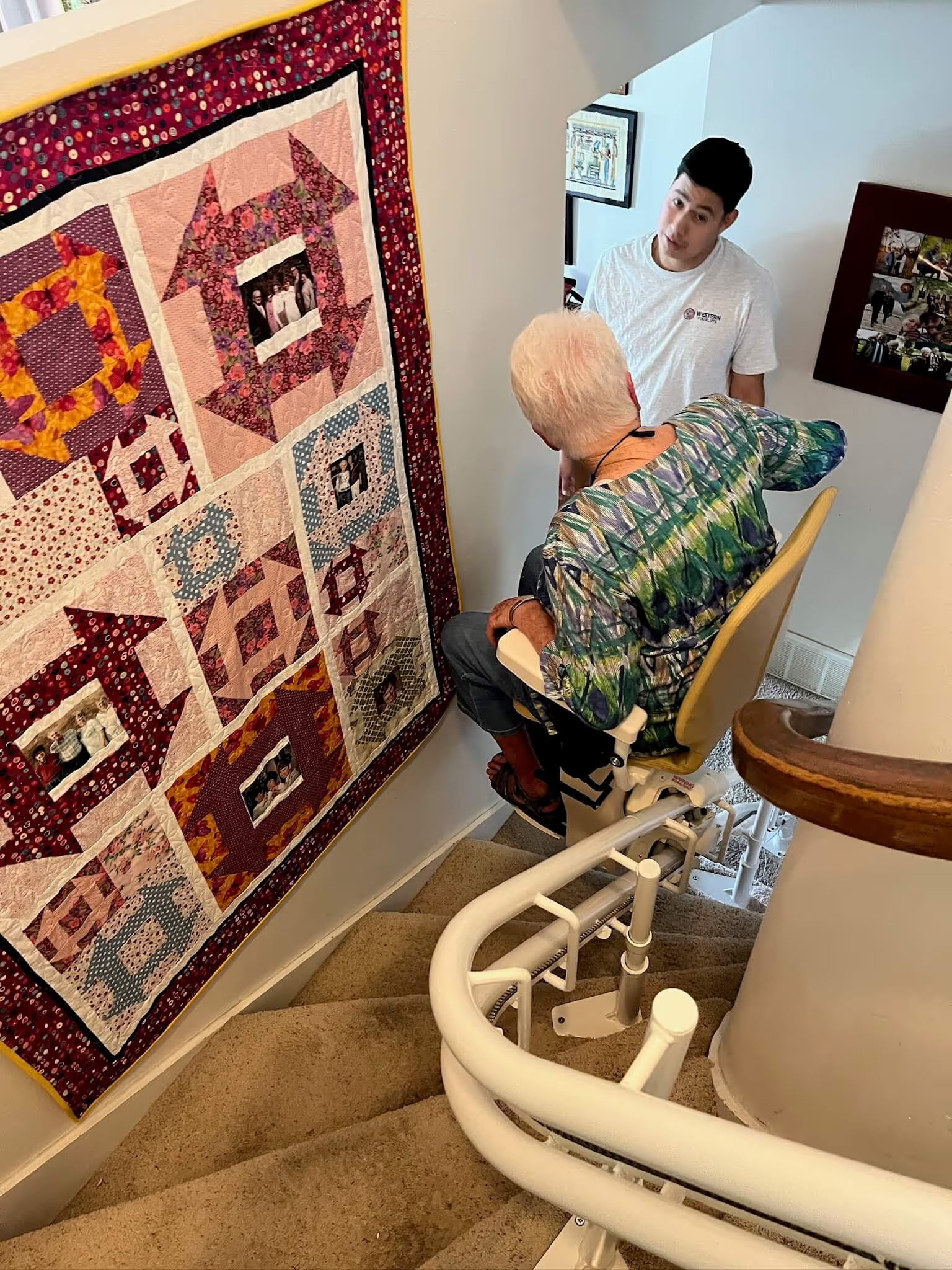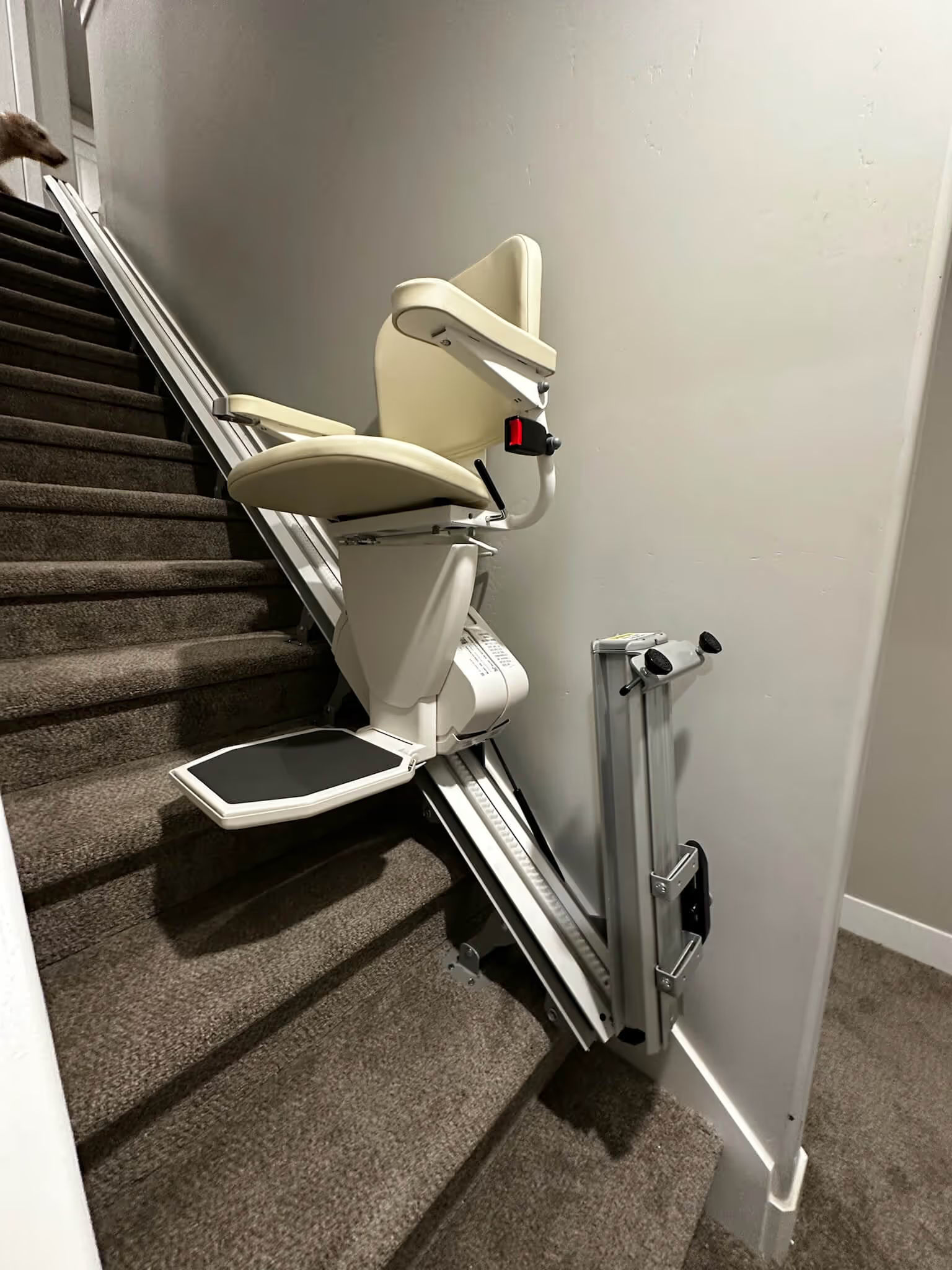Helpful Guide to Common Stairlift Questions and Misconceptions

Table of Contents
- What Is a Stairlift?
- Expert Answers to the Most Common Stairlift Questions Every Homeowners Ask
- Are stairlifts safe to use?
- How are stairlifts installed?
- How much do stairlifts cost?
- How much electricity does a stairlift use?
- How does a stairlift work?
- How much maintenance does a stairlift require?
- Do stairlifts work during power outages?
- Can a stairlift be removed if no longer needed?
- Addressing the Biggest Misconceptions About Stairlifts
- “Stairlifts are only for the elderly.”
- “Stairlifts damage the home.”
- “Stairlifts are noisy and uncomfortable.”
- “They take up too much space.”
- “Installing a stairlift takes weeks.”
- “Stairlifts are too expensive.”
- “Stairlifts cannot be customized.”
- Experience the Difference of True Home Accessibility
Climbing the stairs can quickly become a daily challenge for seniors and those with limited mobility. A stairlift offers a safe, dependable, and comfortable way to move between floors while preserving independence at home. Still, despite their growing use, many misconceptions remain about how stairlifts function, who they’re designed for, and the real benefits they provide.
At Western Stairlifts, we frequently receive inquiries from homeowners who want to improve accessibility but are uncertain about their options. This guide aims to address the common stairlift questions we hear most often and clarify the misconceptions that can prevent people from making informed decisions.
By understanding the real facts about stairlifts, including their design, safety, installation, and cost, you can confidently decide whether this life-enhancing solution is right for your home and your loved ones.
What Is a Stairlift?
A stairlift is a motorized chair that moves along a secure rail installed on your staircase, allowing users to travel up and down safely without strain or risk. Powered by electricity and equipped with modern safety sensors, it integrates smoothly with your home’s layout.
Seniors, individuals recovering from injury or surgery, and people with disabilities or chronic conditions can all benefit from the comfort and safety a stairlift provides. It reduces the physical strain of climbing stairs and helps prevent accidents, offering a reliable solution for limited mobility. Caregivers and family members also gain peace of mind knowing their loved ones can move independently and safely.
Installing a stairlift helps individuals maintain independence, reduce fall risks, and avoid the financial and emotional strain of moving to a single-level home. It’s a practical investment that enhances both safety and quality of life. Moreover, stairlifts can support compliance with Americans with Disabilities Act (ADA) guidelines by promoting accessibility and safe mobility for individuals with disabilities.

Expert Answers to the Most Common Stairlift Questions Every Homeowner Asks
Before investing in a mobility solution, many homeowners want to know how it will fit into their daily routine, what the installation process involves, and how it can improve their comfort and independence at home. Understanding these details makes it easier to choose the right solution with confidence.


1. Are stairlifts safe to use?
Yes, stairlifts are designed with multiple safety features, including seatbelts, footrest sensors, and emergency stop buttons. Many models are designed in alignment with the Americans with Disabilities Act (ADA) principles, ensuring accessibility standards are met for residential use. They also come with battery backup systems that allow operation during a power outage.
2. How are stairlifts installed?
Installation is a straightforward process handled by trained technicians. The stairlift rail is mounted to the stair treads, not the wall, so there is minimal disruption to your home. Most installations take only a few hours, and once completed, the stairlift operates smoothly and quietly.
3. How much do stairlifts cost?
As people start planning for better home mobility, one of the most common stairlift questions they ask is, how much do stairlifts cost? The answer depends on factors such as your staircase type (straight or curved), the model you choose, and any additional features you prefer.
In general, stairlifts can range from around $2,500 for reconditioned models to $15,000 or more for fully customized curved installations, with most standard options falling somewhere between $4,000 - $7,000. Despite these variables, stairlifts are often far more affordable and less disruptive than relocating or undergoing major home renovations.
4. How much electricity does a stairlift use?
Modern stairlifts are designed to be highly energy-efficient, using about the same amount of power as a small household appliance. They operate on rechargeable batteries that draw very little electricity, keeping energy costs low while providing reliable daily use.
5. How does a stairlift work?
In simple terms, a stairlift functions through a motor and gear system that moves the chair smoothly along a rail secured to the staircase, providing a safe and effortless ride up and down the stairs. With easy-to-use controls, you can travel smoothly and safely, powered by a quiet, efficient electric drive.
6. How much maintenance does a stairlift require?
Stairlifts are built for durability and require minimal maintenance. Regular servicing, typically once a year, helps maintain consistent performance and safety. At Western Stairlifts, we offer professional maintenance services and dedicated customer support to keep your stairlift in excellent condition. For simple ways to care for your lift between visits, check out our stairlift maintenance tips.
7. Do stairlifts work during power outages?
Yes. Most stairlifts operate using rechargeable batteries, allowing several trips even when the power goes out. Once power is restored, the batteries automatically recharge, allowing the stairlift to resume normal operation without interruption.
8. Can a stairlift be removed if no longer needed?
Absolutely. Stairlifts can be uninstalled without a major impact on your stairs or walls. The process is quick and leaves minimal marks, restoring your staircase to its original condition.
Addressing the Biggest Misconceptions About Stairlifts

.avif)
1. “Stairlifts are only for the elderly.”
While seniors are often the primary users, stairlifts are beneficial for anyone with mobility challenges. Whether due to surgery recovery, disability, or chronic pain, stairlifts provide safe and reliable access for all ages.
2. “Stairlifts damage the home.”
This is one of the most widespread misconceptions. In reality, stairlifts are installed securely on the stair treads and do not damage walls or flooring. When installed by professionals, the process is clean, efficient, and reversible.
3. “Stairlifts are noisy and uncomfortable.”
Modern stairlifts are engineered for quiet, smooth operation. They include cushioned seats, adjustable armrests, and ergonomic designs for maximum comfort. Users can travel between floors effortlessly without noise or vibration.
4. “They take up too much space.”
Today’s stairlifts are compact and designed to fold neatly when not in use. Foldable footrests, seats, and armrests make them ideal for narrow staircases, ensuring full accessibility for other users of the stairs.
5. “Installing a stairlift takes weeks.”
A standard installation is typically completed in just a few hours. Even for custom curved staircases, professional installation rarely exceeds a couple of days. Western Stairlifts completes every project with efficiency and attention to safety.
6. “Stairlifts are too expensive.”
While stairlifts are a financial commitment, they are far less costly than alternatives such as moving to a new home or remodeling for full accessibility. At Western Stairlifts, we also offer a range of reconditioned options and financing plans for straight models, making this mobility solution more affordable for most homeowners.
7. “Stairlifts cannot be customized.”
This is incorrect. They can be tailored to fit various stair shapes, user needs, and design preferences. From curved rails to color choices, customization allows each stairlift to blend seamlessly with your home’s architecture and décor.
Experience the Difference of True Home Accessibility
Choosing a stairlift requires careful consideration of factors such as your staircase design, mobility level, comfort preferences, and budget. Understanding the different types of stairlifts, including straight, curved, and outdoor models, helps you choose the option that best fits your home and lifestyle. Straight stairlifts are ideal for simple staircases, while curved and outdoor models accommodate turns, landings, and exterior areas with weather-resistant designs.
Professional consultation is essential to ensure that the right model is chosen for your specific needs. At Western Stairlifts, our experts perform on-site assessments to provide accurate recommendations and seamless installation services.
Contact us today to schedule your free evaluation and discover how simple accessibility can be.
Subscribe to Our Newsletter
Stay up to date with the latest news, accessibility tips, and exclusive promotions designed to enhance your mobility, safety, and independence.
.svg)